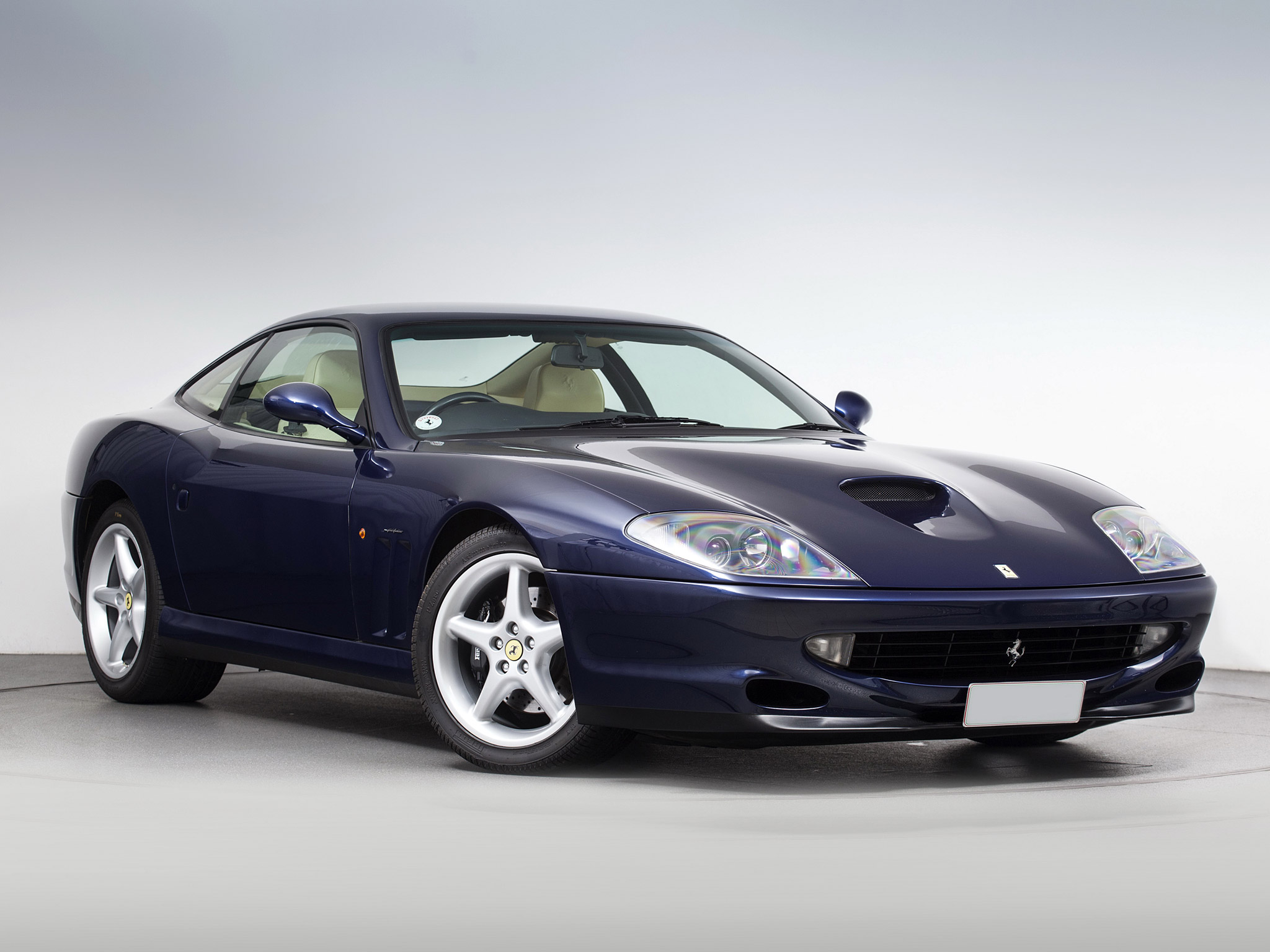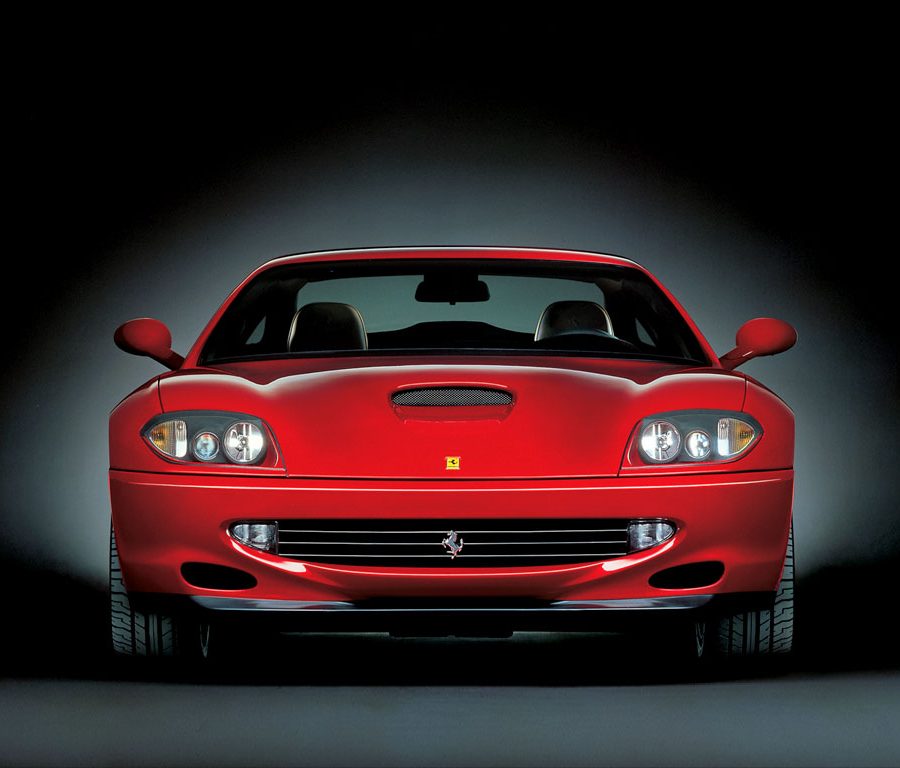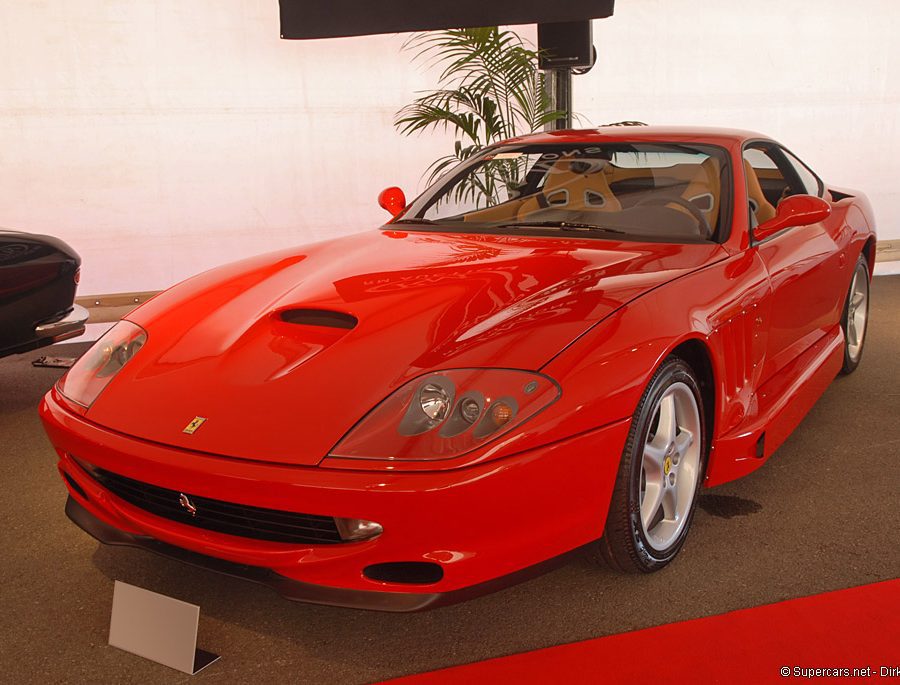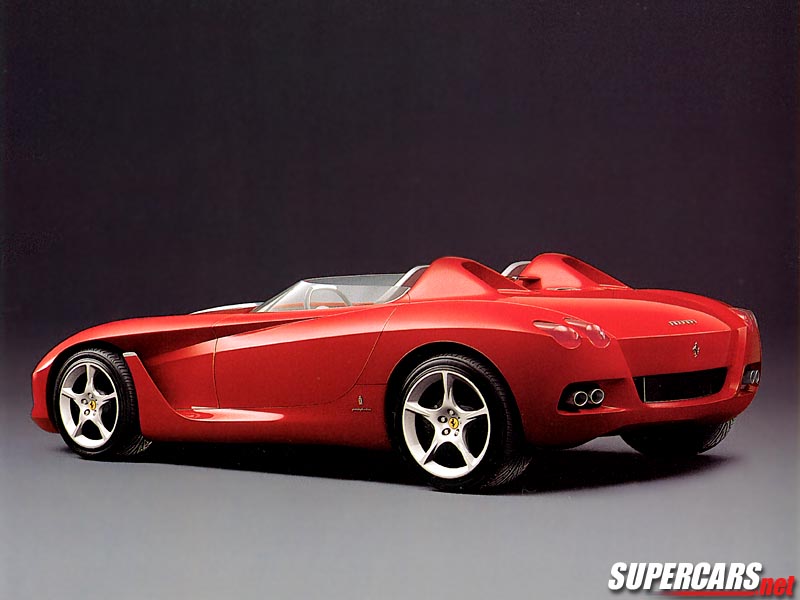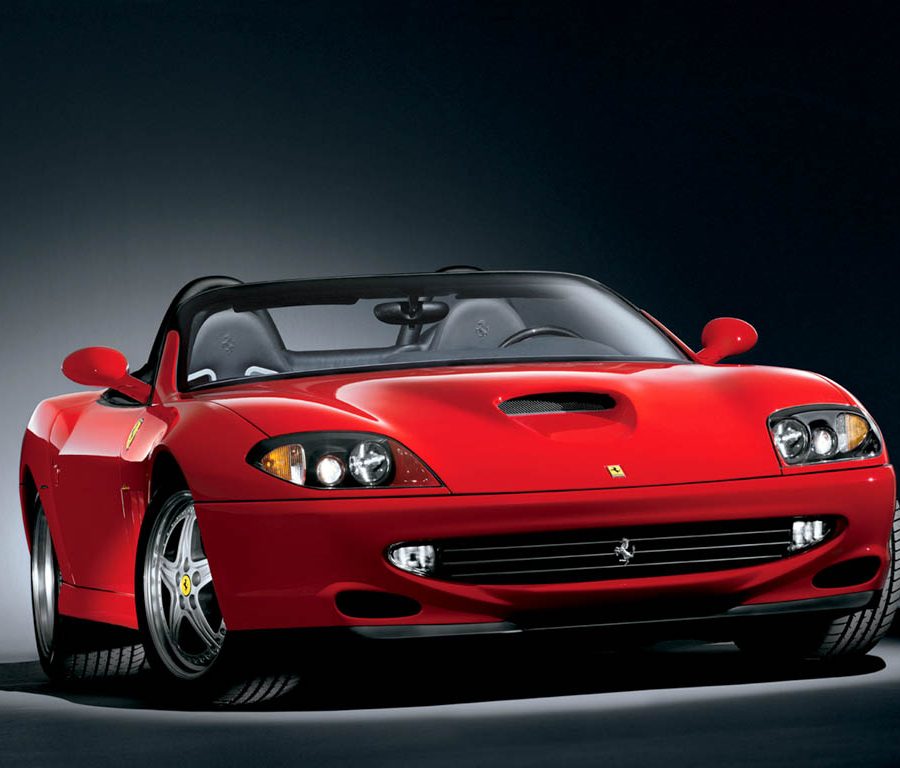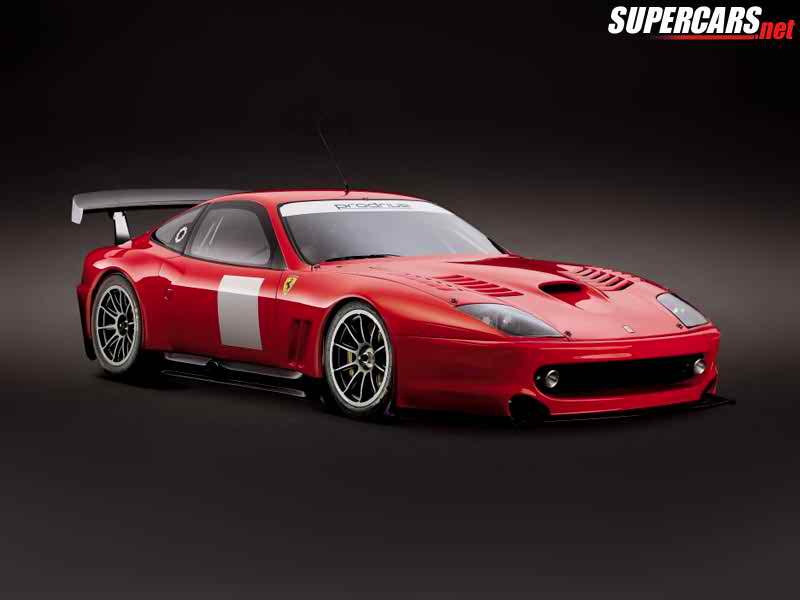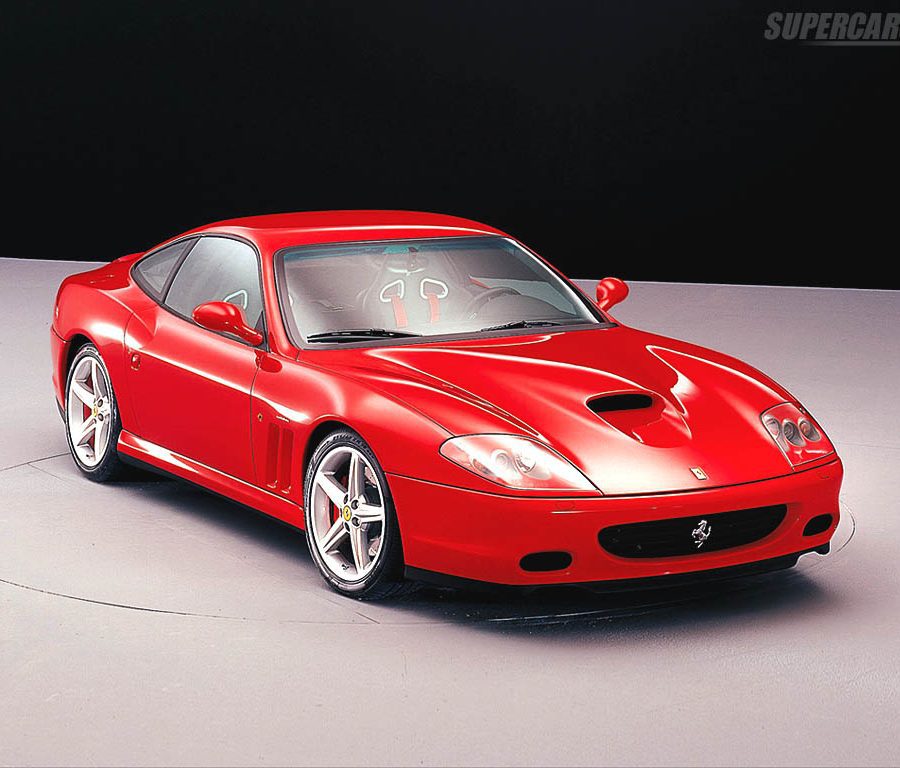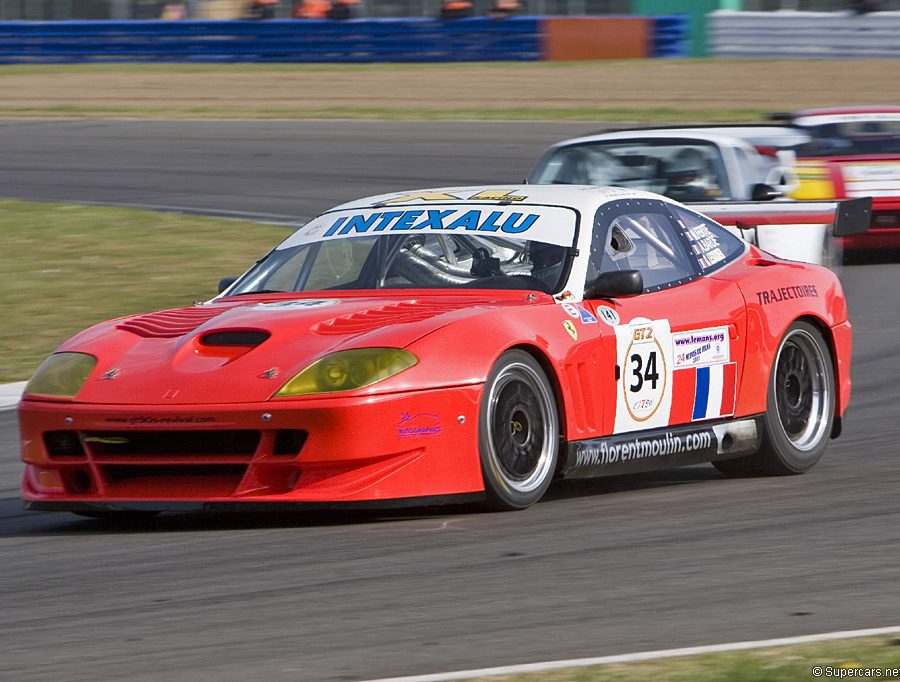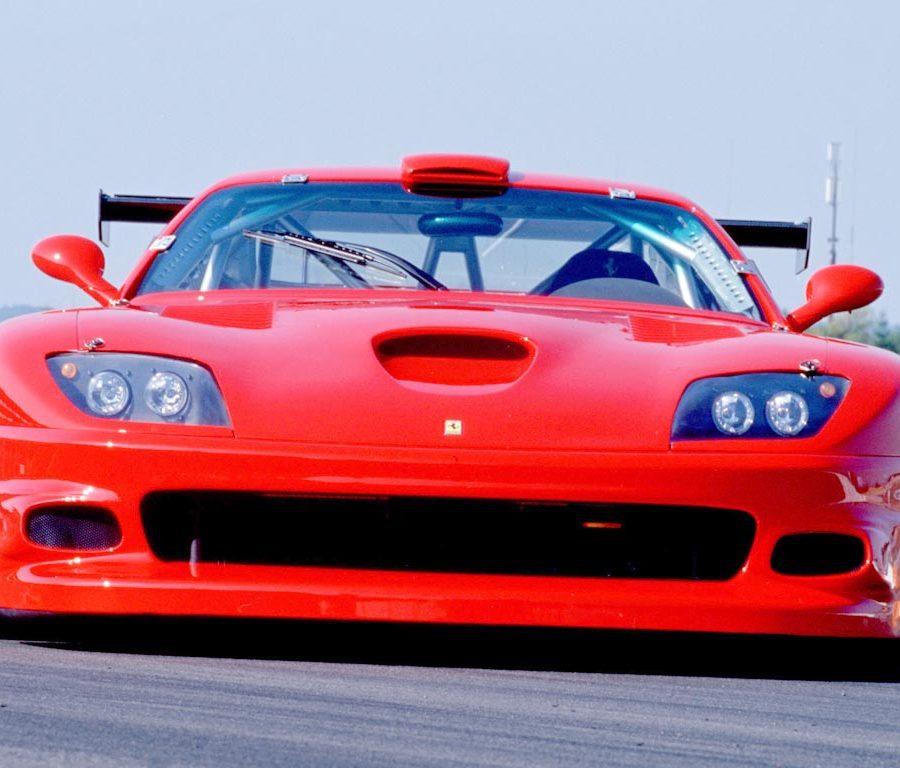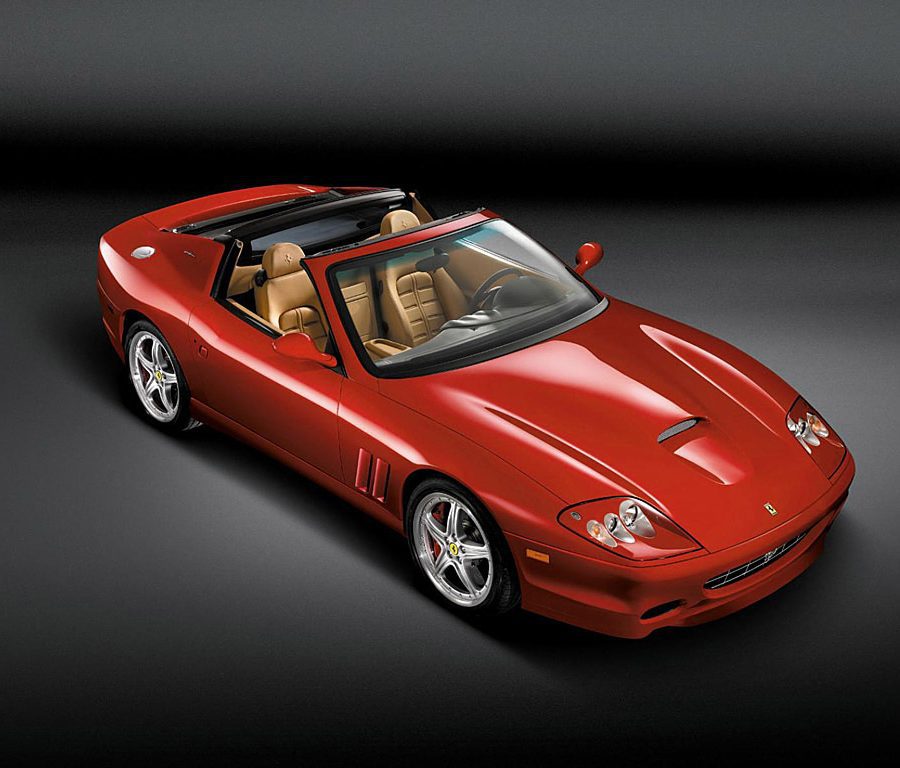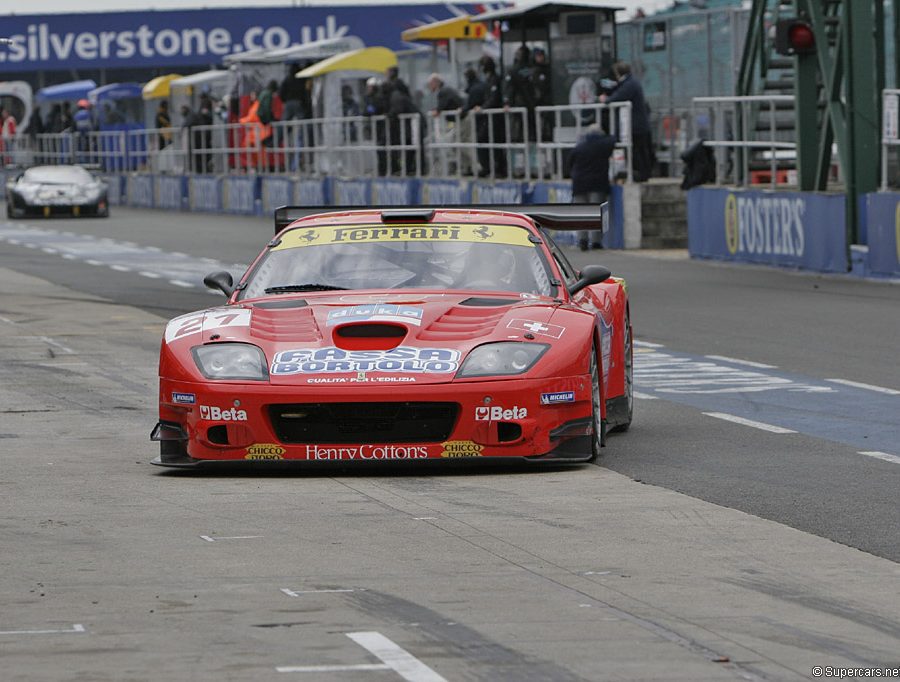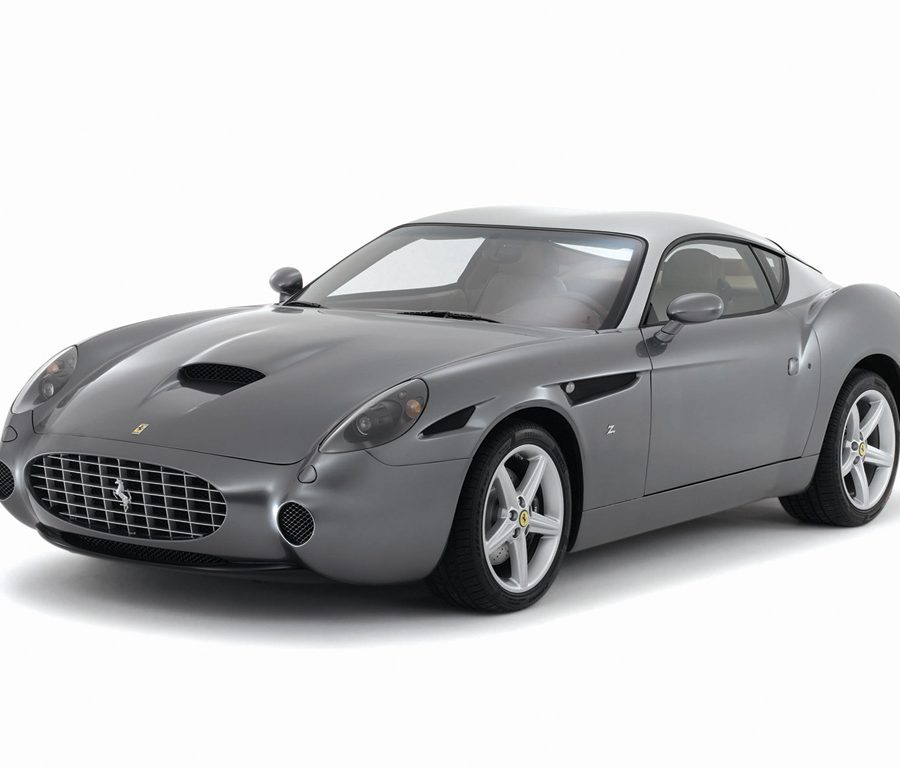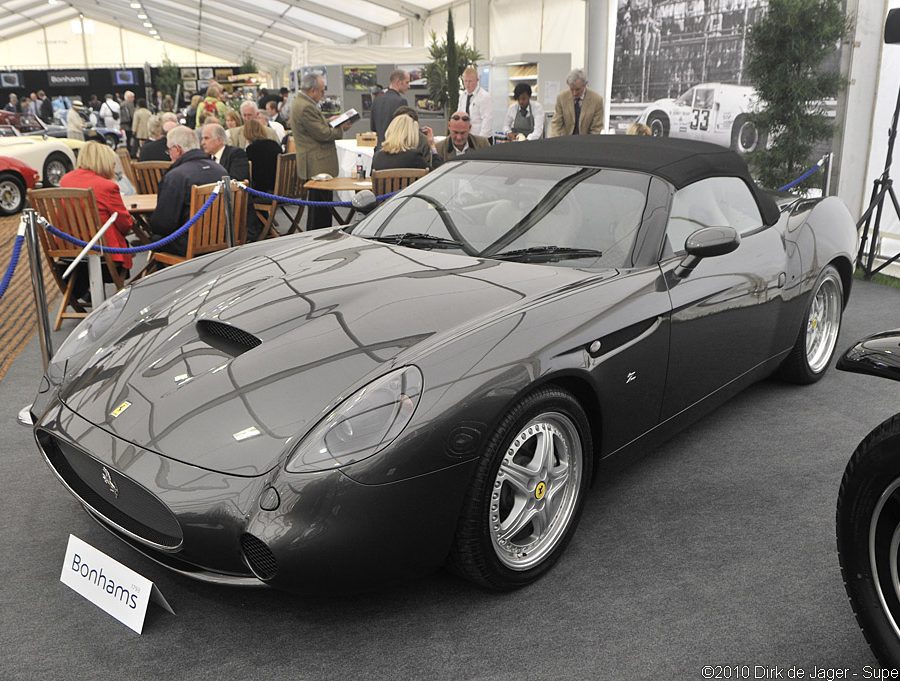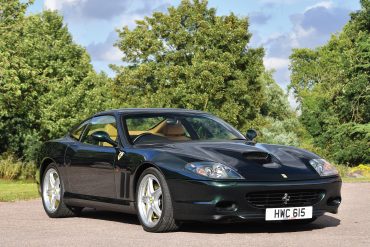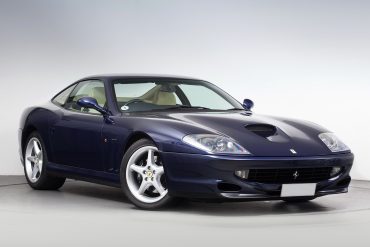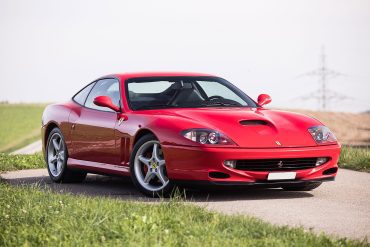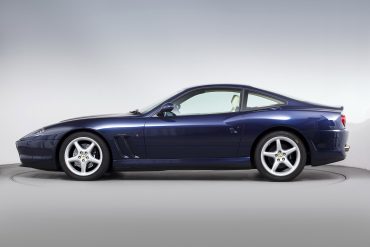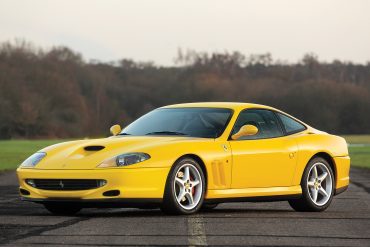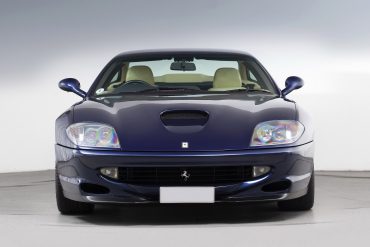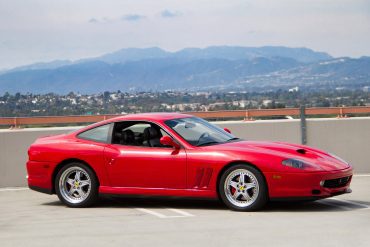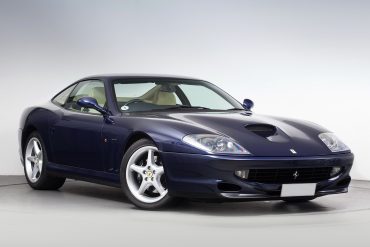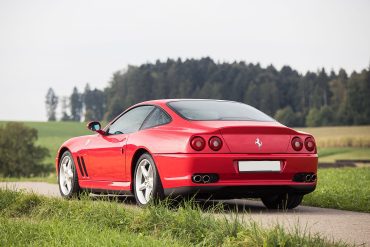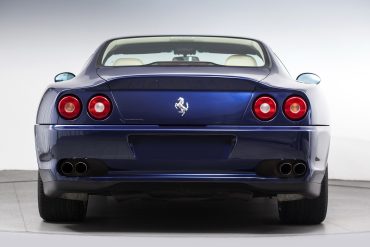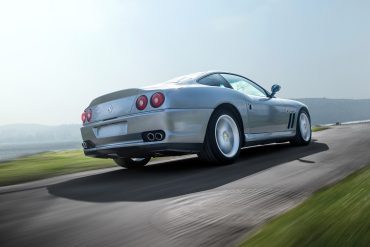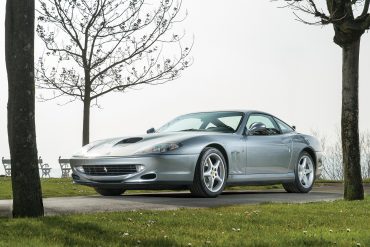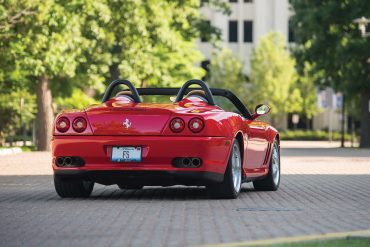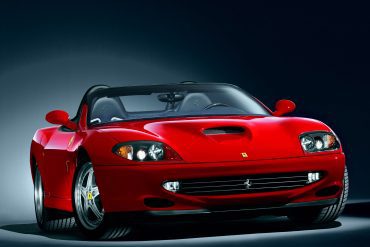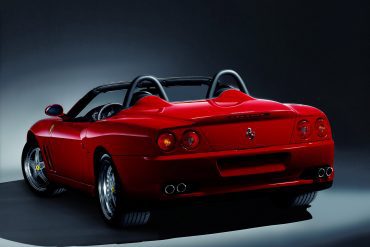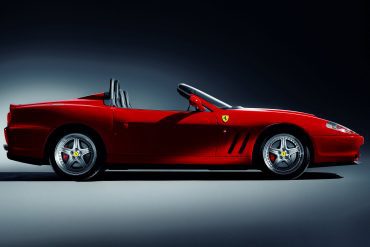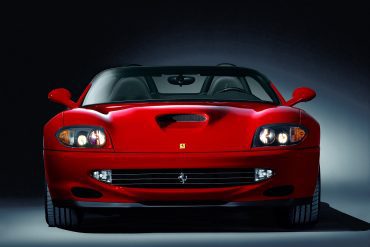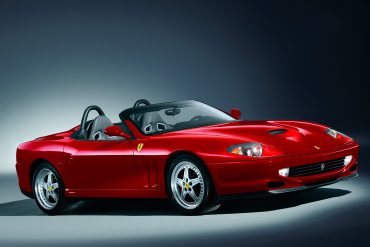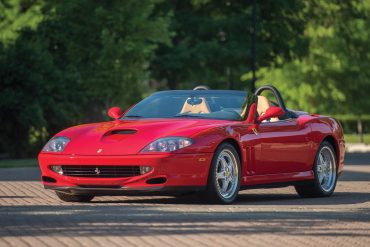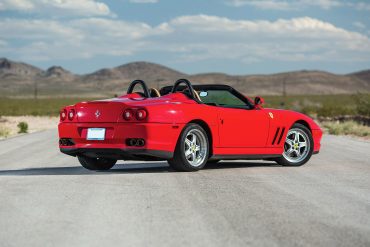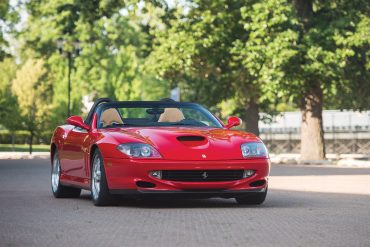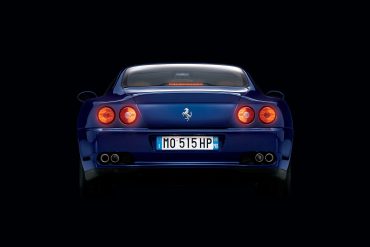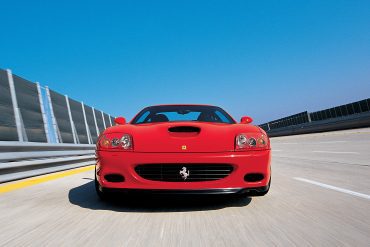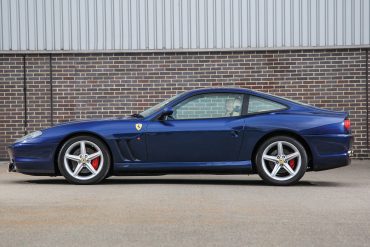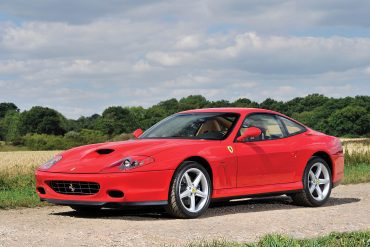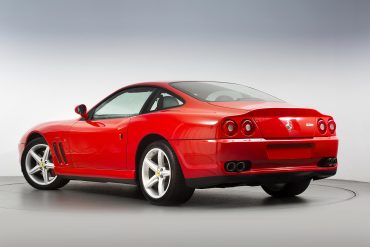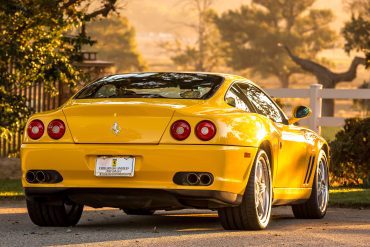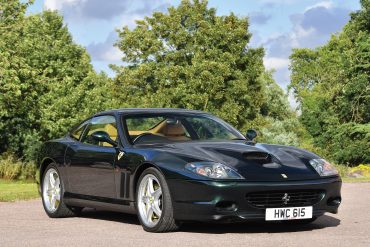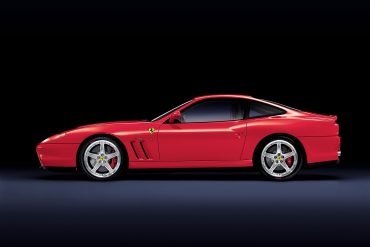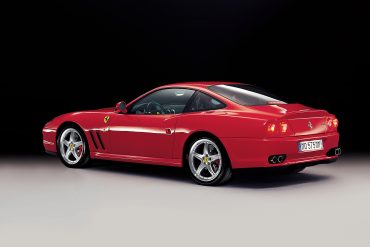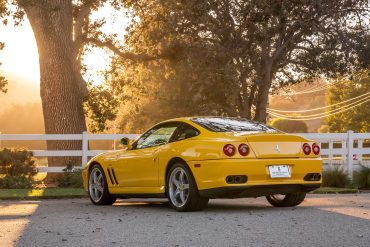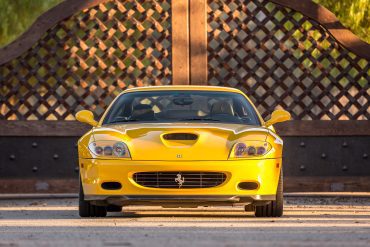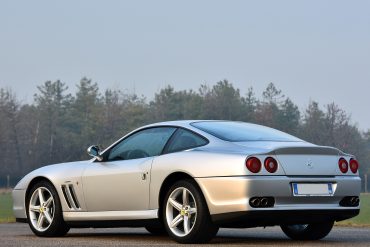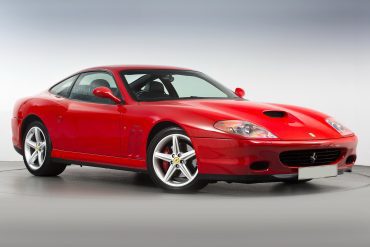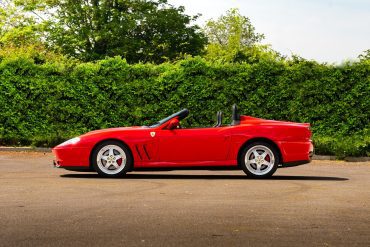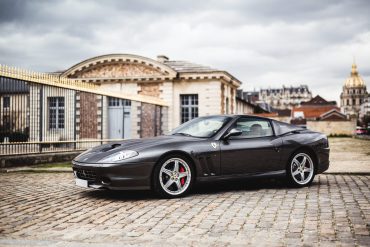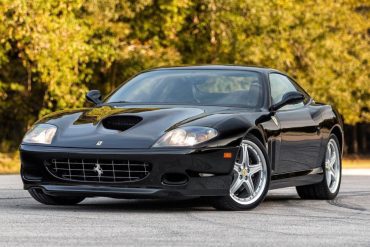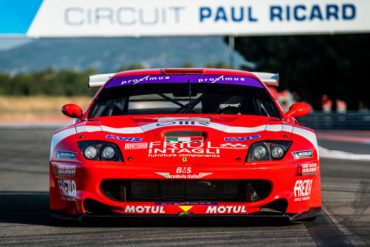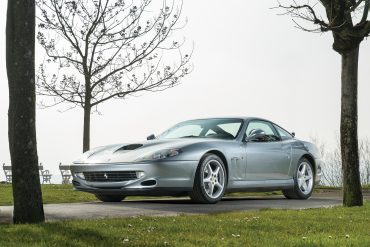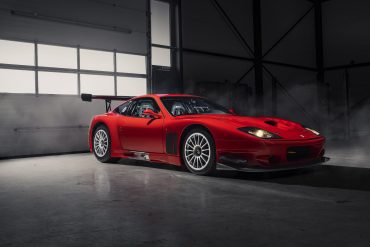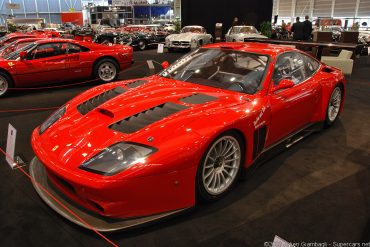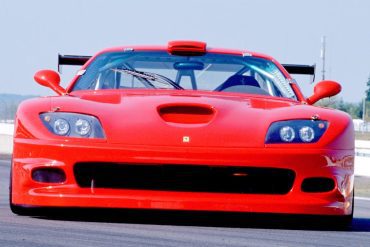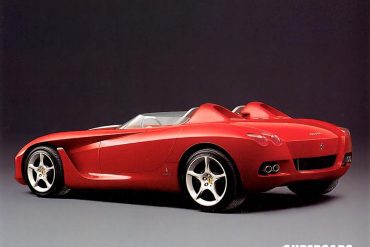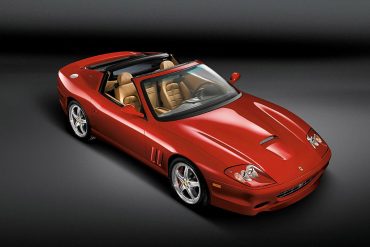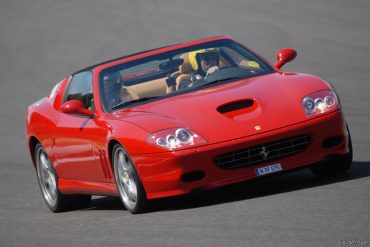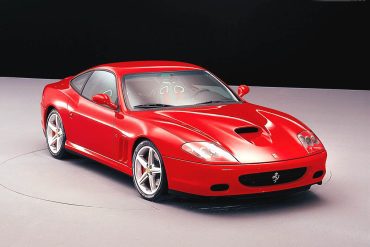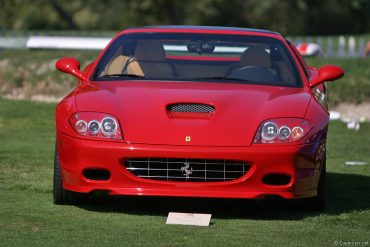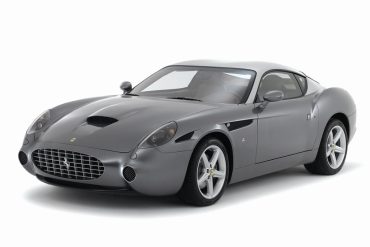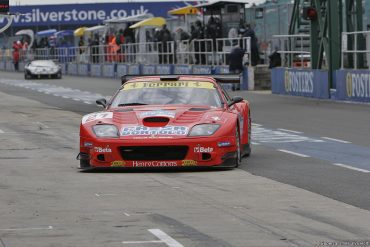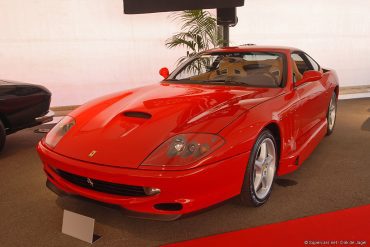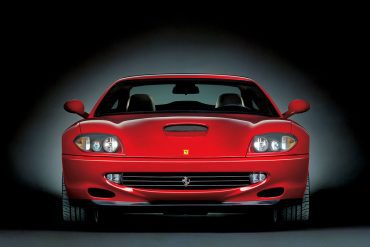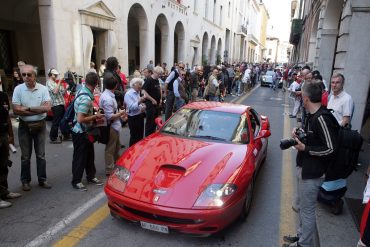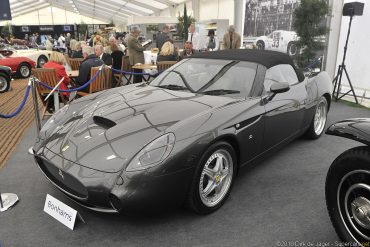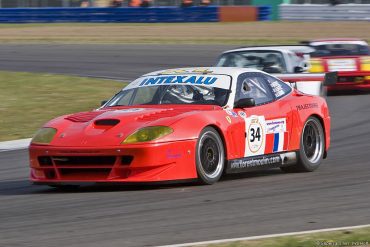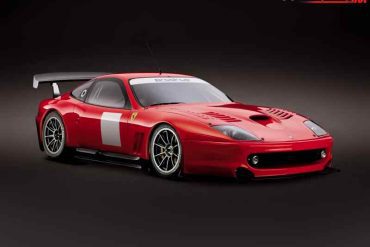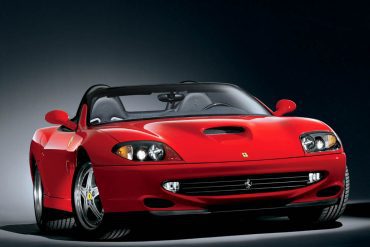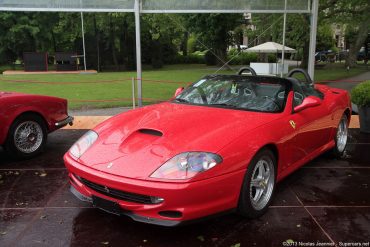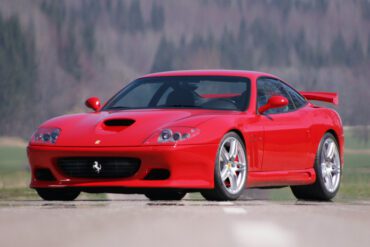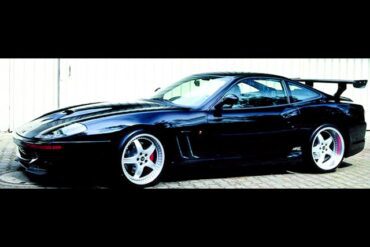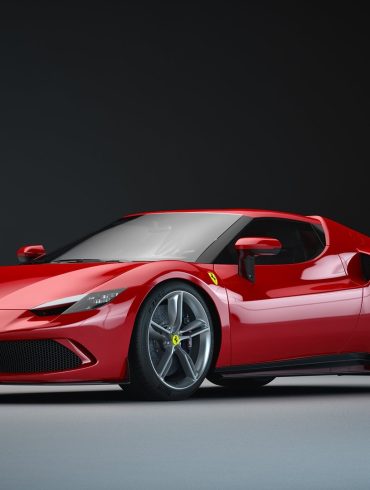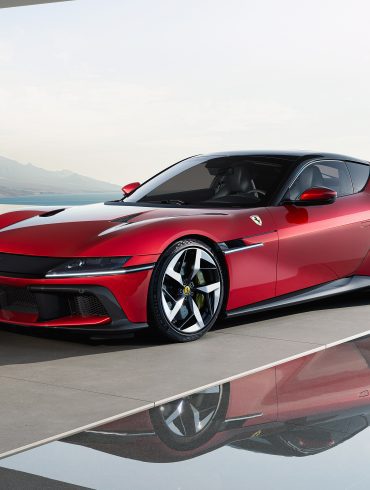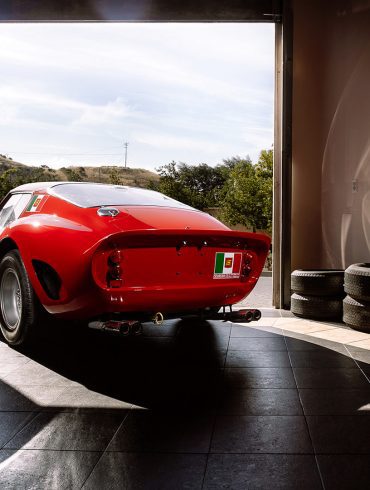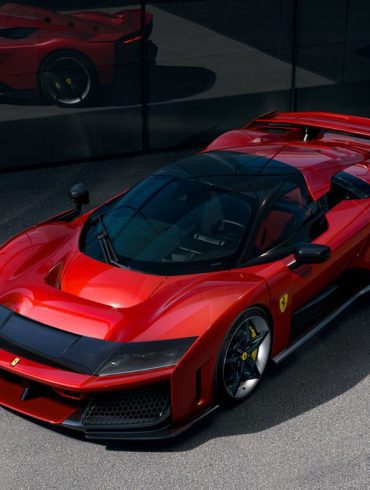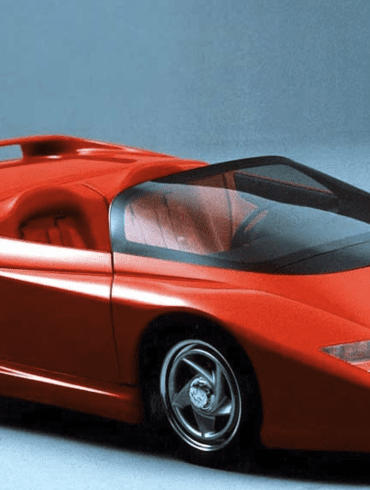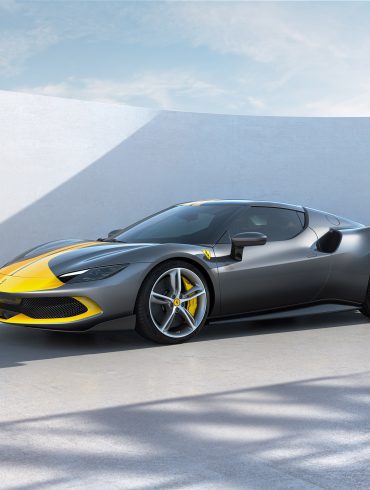Ferrari 550 Maranello With its front engine/rear wheel drive platform, the 550 brought back a classic drivetrain layout not used since the Ferrari 365 GTB/4 Daytona production ceased in 1973. The car was designed for Grand Touring with a higher degree of comfort than the F355 and F50 which were...
Ferrari 550 / 575M
The Ultimate Guide
The Ferrari 550 and 575 Maranello are two of Ferrari’s most iconic grand tourers and defined a new era for front-engine V12 Ferraris. Launched in the late 1990s, the 550 Maranello brought Ferrari back to its roots, pairing a powerful V12 engine with a timeless design. A few years later, the Ferrari 575 evolved the concept, introducing refinements and added performance, making it one of the most complete grand tourers of its time. We’ll explore the history, technical specifications, and variant differences of both models, along with insights into performance, legacy, and what to consider if you’re looking to buy one today.
Overview / Variants / Models In-Depth / Buyer's Guide / Images / More Updates
Ferrari 550 & Ferrari 575M - V12 Classics
The Ferrari 550 Maranello and its successor, the Ferrari 575M Maranello, represent a significant chapter in Ferrari’s history as they marked the brand’s return to front-engine V12 grand tourers after nearly two decades.
Both models combined luxurious grand touring comfort with exhilarating V12 performance, paying homage to classic Ferraris like the 365 GTB/4 “Daytona” while incorporating modern engineering and design. Produced from 1996 to 2006, the 550 and 575M Maranello earned widespread acclaim and continue to be cherished by collectors and enthusiasts. This article delves into the history, performance, variants, legacy, and critical reception of these iconic models.
Ferrari’s Return to the Front-Engine V12 Grand Tourer
After years of focusing on mid-engine V8 and V12 models, Ferrari shifted gears in the mid-1990s to develop a new front-engine V12 grand tourer, bringing back a configuration that hadn’t been seen in Ferrari’s lineup since the 1970s.
The 550 Maranello was introduced in 1996 as a high-performance GT car aimed at delivering both comfort and performance, a car designed to cover long distances at high speed while maintaining Ferrari’s signature driving dynamics.
The 550 Maranello was followed by the 575M Maranello in 2002. The “M” stood for “Modificata,” or “modified,” as the 575 brought several updates to the 550’s platform, including more power, an upgraded interior, and the option of an F1-style automated manual transmission. These refinements allowed the 575M to stay competitive against newer grand tourers of the early 2000s while maintaining the 550’s charm and capability.
Classic Elegance Meets Modern Aerodynamics
Pininfarina, Ferrari’s legendary design partner, was responsible for the styling of both the 550 and 575M Maranello. The design was a departure from the dramatic lines of the Testarossa and F355, favoring a clean, timeless aesthetic inspired by Ferrari’s grand touring heritage.
Aerodynamic Efficiency: The 550’s design prioritized aerodynamics, with elements like a subtle rear spoiler and air intakes positioned for optimal cooling. The 575M maintained this focus on functionality, with only slight changes to the body to improve aerodynamics and stability.
Interior Comfort and Luxury: Inside, both models offered a spacious, driver-focused cabin with leather upholstery, ergonomic seats, and a blend of luxury and sportiness. The 575M introduced more refined materials and options, making it an even more comfortable and stylish grand tourer.
Attention to Detail: The 550 and 575M featured iconic design details like the exposed gated shifter on manual models, a throwback to classic Ferraris. The understated design emphasized elegance and luxury, qualities that appeal to drivers who appreciate timeless design over flashy aesthetics.
Car and Driver described the 550 Maranello as “elegant and powerful, understated yet utterly captivating,” noting how Ferrari successfully balanced classic and contemporary elements.
Front-Engine V12 Brilliance
At the heart of both the 550 and 575M was a naturally aspirated V12 engine that delivered exhilarating performance with remarkable smoothness and refinement.
Ferrari 550 Maranello
The 550 Maranello featured a 5.5-liter V12 engine producing 485 horsepower and 419 lb-ft of torque, enabling it to accelerate from 0 to 60 mph in around 4.2 seconds and reach a top speed of 199 mph. Paired with a traditional 6-speed gated manual transmission, the 550 offered a pure driving experience that appealed to enthusiasts seeking an engaging and analog Ferrari.
Chassis and Handling: The 550 utilized a steel monocoque chassis with aluminum panels, giving it the necessary rigidity and lightness to balance luxury and performance. The suspension was designed to provide stability at high speeds while delivering agile handling, especially for a front-engine GT car.
Balanced Dynamics: Ferrari achieved near-perfect weight distribution with the 550, placing the engine behind the front axle and positioning the fuel tank and transmission at the rear. This balance, combined with a limited-slip differential and advanced suspension, made the 550 surprisingly nimble for a grand tourer.
Evo Magazine praised the 550’s handling, stating, “It might be a grand tourer, but the 550 Maranello is agile, engaging, and rewarding to drive, with a character that encourages spirited driving.”
Ferrari 575M Maranello
The 575M took the 550’s platform and enhanced it with a larger 5.75-liter V12 engine, increasing power output to 508 horsepower and 434 lb-ft of torque. This allowed the 575M to achieve a 0 to 60 mph time of around 4.1 seconds and a top speed of 202 mph. The 575M also offered Ferrari’s F1-style automated manual transmission as an option, appealing to a broader range of buyers and reflecting Ferrari’s focus on integrating Formula 1 technology.
Improved Braking and Suspension: The 575M featured larger brakes and an updated adaptive suspension system that adjusted damper settings based on road conditions, further enhancing the car’s handling and comfort.
F1 Transmission Option: The 575M was Ferrari’s first V12 grand tourer to offer an F1 transmission, which enabled quicker shifts and improved performance. While purists preferred the gated manual, the F1 transmission offered a modern alternative for those seeking convenience.
Motor Trend described the 575M as “more refined and powerful than ever,” noting that it “raises the standard for high-performance grand tourers.”
Special Editions and Racing Models
Both the 550 and 575M inspired special variants and racing models that amplified their appeal:
550 Barchetta Pininfarina: Introduced in 2001, this open-top version of the 550 Maranello was a limited edition with just 448 units produced. It featured a shortened windshield, additional chassis reinforcements, and a unique convertible roof for fair-weather driving. The Barchetta emphasized the 550’s grand touring style with a more engaging, open-air experience.
575M Superamerica: In 2005, Ferrari introduced the 575M Superamerica, a limited-edition model with a unique “Revocromico” rotating hardtop that allowed it to function as both a coupe and convertible. With only 559 units produced, the Superamerica featured an upgraded 533-hp V12 engine, making it one of the most powerful variants in the series.
550/575 GTC: Both models saw success on the racing circuit with the 550 GTC and 575 GTC, which competed in events like the FIA GT Championship. These race-spec versions were extensively modified for performance, showcasing the platform’s capability even in professional racing.
Widespread Acclaim
Upon their releases, both the 550 and 575M Maranello were met with critical acclaim. Reviewers praised Ferrari’s decision to return to a front-engine V12 grand tourer, a configuration that many enthusiasts felt had been missing from the lineup for too long.
Autocar called the 550 Maranello “an Italian masterpiece,” highlighting its ability to deliver both power and comfort in a way that felt effortless. They noted that the car felt “supremely balanced and rewarding,” particularly when tackling high-speed corners on open roads.
Top Gear reviewed the 575M and remarked on its blend of performance and comfort, stating that it was “a Ferrari that you could comfortably drive cross-country while still having the excitement of a thoroughbred sports car at your fingertips.”
A Modern Classic
The Ferrari 550 and 575M Maranello are now regarded as modern classics, revered for their combination of timeless design, analog driving experience, and naturally aspirated V12 power. These cars marked a return to Ferrari’s roots in grand touring and set a precedent for later front-engine V12 models like the 599 GTB Fiorano and the F12berlinetta.
The 550 and 575M appeal to collectors and enthusiasts who value Ferrari’s classic design language and the thrill of a naturally aspirated V12 engine. With Ferrari’s shift toward hybrid and turbocharged technology, the 550 and 575M Maranello represent the end of an era in Ferrari’s history, making them highly desirable for those seeking a pure and unfiltered driving experience.
Desirability and Investment Potential
Both the 550 and 575M have seen increased interest from collectors in recent years, with limited-edition models like the 550 Barchetta and 575M Superamerica commanding premium prices:
Rising Values: Prices for well-maintained 550 and 575M models have been steadily appreciating. Low-mileage, original-condition cars with complete service records are particularly desirable and likely to continue appreciating in value.
Manual Transmission Appeal: The gated manual transmission in both models is highly sought after, especially as Ferrari moved to automated transmissions in later models. Manual-equipped cars are more engaging and command a premium among enthusiasts.
Limited Editions: The 550 Barchetta and 575M Superamerica, due to their rarity and unique design features, are already highly collectible and are expected to appreciate further.
A Pair of Timeless Grand Tourers
The Ferrari 550 Maranello and 575M Maranello stand as testament to Ferrari’s commitment to creating elegant yet powerful grand tourers. Their blend of luxury, performance, and understated design has earned them a place in Ferrari’s history as modern classics. These cars appeal to a new generation of collectors who value analog driving experiences and naturally aspirated engines, qualities that have become rare in the world of high-performance cars.
With their timeless appeal and impressive performance, the Ferrari 550 and 575M Maranello continue to captivate enthusiasts who seek a true grand tourer experience. Whether appreciated for their design, admired for their V12 engines, or valued as part of Ferrari’s storied legacy, these models have secured their place among Ferrari’s most iconic creations.
Ferrari 550 Specs
Manufacturer: Ferrari
Also called: Ferrari 550 Maranello
Production: 1996 - 2002
Assembly: Maranello, Italy
Designer:
Lorenzo Ramaciotti, Elvio D'Aprile
Class: Grand tourer (S)
Body style: 2-door berlinetta (Maranello), 2-door roadster (Barchetta)
Layout: Front-engine, RWD
Engine: 5.5 L F133 A/C V12
Power: 478 hp
Transmission: 6-speed manual
Wheelbase: 2,500 mm (98.4 in)
Length: 4,550 mm (179.1 in)
Width: 1,935 mm (76.2 in)
Height: 1,277 mm (50.3 in) (berlinetta), 1,258 mm (49.5 in), (barchetta)
Kerb weight: 1,774 kg (3,912 lb)
Predecessor: Ferrari 365 GTB/4 "Daytona"
Successor: Ferrari 575M Maranello
Ferrari 575M Specs
Manufacturer: Ferrari
Production: 2002–2006
Assembly: Maranello, Italy
Designer: Lorenzo Ramaciotti
Class: Grand tourer (S)
Body style: 2-door berlinetta, 2-door retractable hard-top convertible (Superamerica)
Layout: Front-engine, RWD
Engine: 5.7 L F133 E/G V12
Power: 575M Maranello: 508 hp, Superamerica: 533 hp
Transmission: 6-speed manual, 6-speed "F1" Graziano auto-manual
Wheelbase: 2,500 mm (98.4 in)
Length: 4,550 mm (179.1 in)
Width: 1,935 mm (76.2 in)
Height: 1,277 mm (50.3 in)
Curb weight: 1,853 kg (4,085 lb), 1,905 kg (4,200 lb) (Superamerica)
Predecessor: Ferrari 550 Maranello
Successor: Ferrari 599 GTB Fiorano
The 550 Maranello is a proper Ferrari. It's a car that evokes the spirit of classic front-engined V12 Ferraris, while offering modern performance and technology.
EVO Magazine (at the time of launch)
Ferrari 550 & 575 Variants
With its front engine/rear wheel drive platform, the 550 brought back a classic drivetrain layout not used since the Ferrari 365 GTB/4 Daytona production ceased in 1973. Named is honor of Ferrari's Headquarters in Maranello the 550 was first introduced in 1996. There was a special edition 550 Barchetta Pininfarina that was specifically designed to be reminiscent of legendary Ferrari road race stars of the likes of the 166 MM, the 250 GT California and the 365 GTS4 Daytona. Serving as a successor to the radical 550 Maranello, the 575M was got the M suffix which stands for modificato (modified in italian) which stresses how many areas on the car have be rethought. While many of the original styling characteristics had been retained, Ferrari substantially re-engineered the engine, transmission and driveline for the new car. The engine was an enlarged version of the V12 found in the original 550. Introduced in 2005, the Ferrari Superamerica was a convertible version of the 575M Maranello and it was a limited edition.
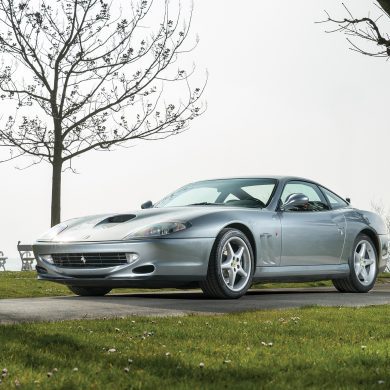
Ferrari 550 Maranello
Type: Production Car
Years: 1996 - 2002
Production: 3,083 units
Engine: 5.5 L Nat Asp V12
Power: 478 bhp @ 7,000 rpm
Torque: 419 lb/ft @ 5000 rpm
0-60 mph: 4.4 seconds
Top Speed: 199 mph
The steel chassis is a modified version of the one in the F456 and supports an aluminum alloy body. In 2002 the 550 was replaced by the 575M Maranello, which was an all-around improved version (modificata in Ferrari parlance) of the car, rather than an all-new construction.In total 3,083 units of the 550 Maranello were produced. Learn more.
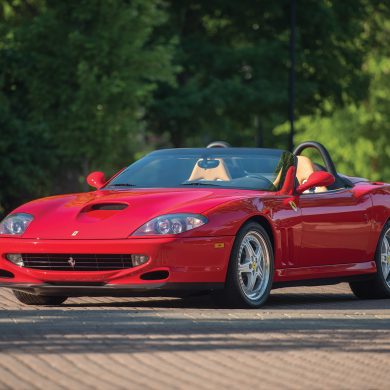
Ferrari 550 Barchetta
Type: Special Edition
Years: 2001
Production: 448 units
Engine: 5.5 L Nat Asp V12
Power: 478 bhp @ 7,000 rpm
Torque: 419 lb/ft @ 5000 rpm
0-60 mph: 4.4 seconds
Top Speed: 186 mph
Unveiled at the Paris Show in 2000, the 550 Barchetta Pininfarina was so named to commemorate the 70th anniversary of Ferrari’s coachbuilder and stylist. A strictly limited edition of just 448 numbered cars was built, with the last leaving the factory in December 2001. Each car was numbered, displayed on a special in-car plaque. Learn more.
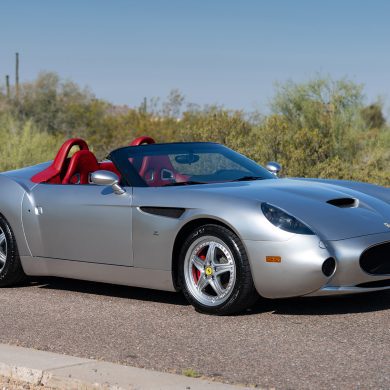
Ferrari 550 GTZ Barchetta
Type: Coachbuilt Special
Years: 2008
Production: 3 units
Engine: 5.5 L Nat Asp V12
Power: 515 bhp @ 7250 rpm
Torque: 434 ft lbs @ 5250 rpm
0-60 mph: N/A
Top Speed: N/A
Zagato’s 550 GTZ is one of the secret Ferraris that was made from the prying eyes of the press and Ferrari themselves. We first broke the story in 2007 when the Quail Motorsports Gathering had an advertisement for one in their program catalog. Since then, Zagato has denied the existence of the model despite including it in their Zagato Milano Official Book. Learn more.
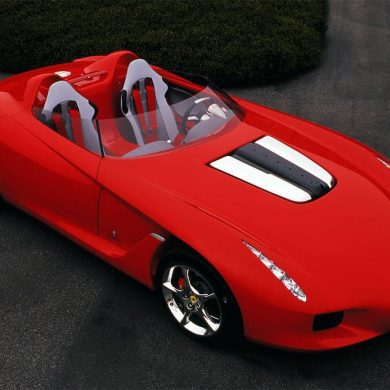
Ferrari Rossa
Type: Concept Car
Years: 2000
Production: 1 unit
Engine: 5.5 L Nat Asp V12
Power: 485 bhp @ 7,000 rpm
Torque: 419 lb/ft @ 5000 rpm
0-60 mph: 4.4 seconds
Top Speed: 199 mph
Pininfarina launched to Rossa prototype at the 2000 Paris Motor Show. It was modern interpretation of the 1958 Ferrari 250 Testa Rossa, a classic, purpose-built race car with an unorthodox body by Scaglietti & C. It was built upon a 2000 Ferrari 550 Barchetta Pininfarina chassis which had the necessary rigidity. Learn more.
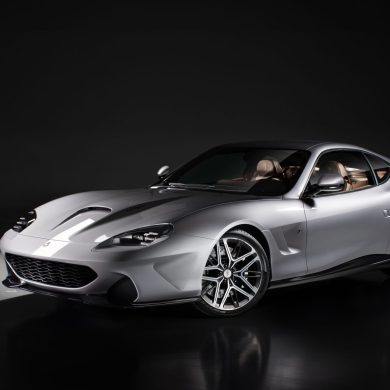
Touring Superleggera Veloce12
Type: Coachbuilt Special
Years: 2024
Production: N/A
Engine: 5.5 L Nat Asp V12
Power: 485 bhp @ 7,000 rpm
Torque: 419 lb/ft @ 5000 rpm
0-60 mph: 4.4 seconds
Top Speed: 199 mph
The Veloce12 is a curvaceous adaptation of the Ferrari 550 from the late 1990s. The Veloce12 wears unique bodywork and has a reworked version of the 550's naturally aspirated 5.5-liter V-12 making 503 horsepower. Also fitted an adaptive suspension and powerful Brembo brakes.
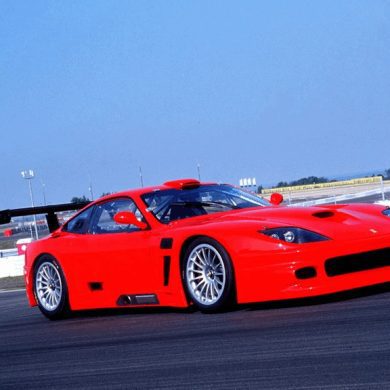
Ferrari 550 GT
Type: Race Car
Years: 2000 - 2001
Production: 1 unit
Engine: 5.5 L Nat Asp V12
Power: ~ 600 bhp
Torque: N/A
0-60 mph: N/A
Top Speed: N/A
The first racing 550, known as 550 GT, was built for French team Red Racing to comply with international sporting regulations. The project was developed by Michel Enjolras and assembled in the Italtecnica workshop. The car was first tested in April 1999 and was used in the GT3 class of the FFSA GT Championship.
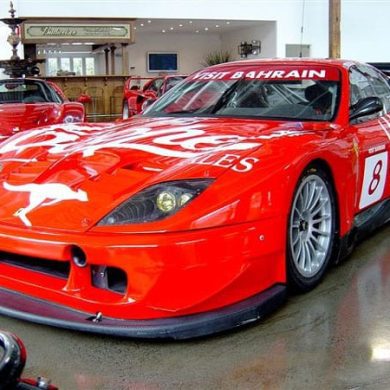
Ferrari 550 Millennio/Italtecnica
Type: Race Car
Years: 2000 - 2001
Production: 1 unit
Engine: 6.0 L Nat Asp V12
Power: ~ 600 bhp
Torque: N/A
0-60 mph: N/A
Top Speed: N/A
In 2000, with financial support from some investors led by Stéphane Ratel, Italtecnica created another 550 race car meeting the more powerful GT regulations in the FIA GT Championship, the car being named 550 Millennio. Raced in the FIA GT Championship, the American Le Mans Series, and Nations Cup GT Championship. “Millennio” featured a 600 hp 6–litre V–12.
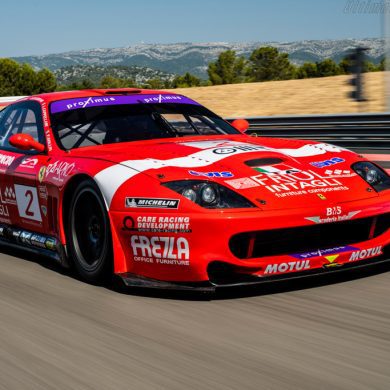
Ferrari 550 GTS
Type: Race Car
Years: 2000
Production: 2 units
Engine: 5.5 L Nat Asp V12
Power: ~ 600 bhp
Torque: N/A
0-60 mph: N/A
Top Speed: N/A
In November 2000, German entrepreneur and engineer Franz Wieth launched another racing version of the 550, developed by Baumgartner Sportwagen Technik, and named 550 GTS. Two cars were built, with Wieth Racing entering one in the 2001 FIA GT Championship, then again in 2003, 2004 and 2005. In 2006 the Wieth's Ferrari scored two wins in the Euro GT Series.

Ferrari 550 GTS (Prodrive)
Type: Race Car
Years: 2003 - 2004
Production: N/A units
Engine: 5.5 L Nat Asp V12
Power: 603.4 bhp
Torque: N/A
0-60 mph: N/A seconds
Top Speed: 199 mph
Commissioned by Frédéric Dor's company Care Racing Development, Prodrive extensively worked on the 550, transforming it into a machine that we might see run the AMLS, European Lemans Series and the 24 Hours of Lemans. Much work was done to reduce weight with most of the savings coming from new carbon fibre bodywork. Learn more.
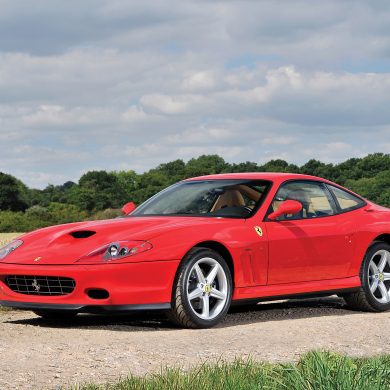
Ferrari 575M Maranello
Type: Production Car
Years: 2002 - 2006
Production: 2,056 units
Engine: 5.7 L Nat Asp V12
Power: 508 bhp @ 7,250 rpm
Torque: 434 lb/ft @ 5250 rpm
0-60 mph: 4.2 seconds
Top Speed: 202 mph
The 575M V12 retained much of the same design elements as before with 4 valves per cylinder, twin overhead camshafts in an all aluminum design. As an option, the 575M offered an F1-style gear change, the first time a road-going car has implemented this technology on a V12 platform. Overall, a better all-round package than the 550. Learn more.
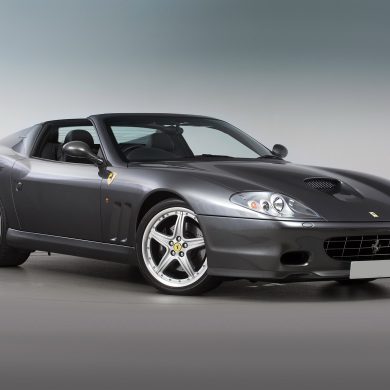
Ferrari 575M Superamerica
Type: Special Edition
Years: 2005
Production: 559 units
Engine: 5.7 L Nat Asp V12
Power: 540 bhp @ 7250 rpm
Torque: 434 lb/ft @ 5250 rpm
0-60 mph: 4.1 seconds
Top Speed: 199 mph
The Superamerica featured an electrochromic glass panel roof which rotated 180° at the rear to lie flat over the boot. The Superamerica used the higher-output tune of the V12 engine used on the 575M and Ferrari marketed it as the world's fastest convertible car. The GTC handling package was optional. Total production amounted to 559 units. Learn more.
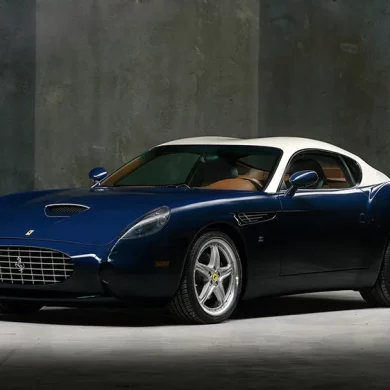
Ferrari 575 GTZ Zagato
Type: Coachbuilt Special
Years: 2006 - 2008
Production: 6 units
Engine: 5.7 L Nat Asp V12
Power: 515 bhp @ 7,250 rpm
Torque: 434 lb/ft @ 5250 rpm
0-60 mph: 4.2 seconds
Top Speed: 202 mph
It was in 2005 that Japanese collector Yoshiyuki Hayashi approached Zagato with a request for a bespoke 12-cylinder Ferrari. Although Hayashi’s car would be heavily inspired by a car built half a century earlier, Andrea Zagato was keen to ensure the rebodied 575 didn’t look too retro. In all, a total of 6 units were produced through 2008. Learn more.
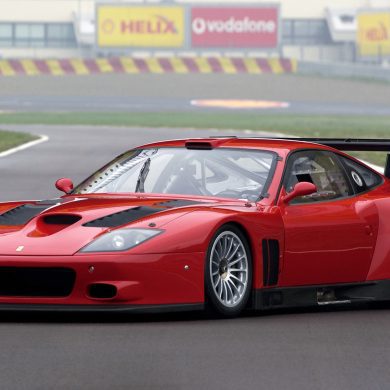
Ferrari 575 GTC
Type: Race Car
Years: 2003 - 2005
Production: N/A
Engine: 6.0 L Nat Asp V12
Power: 600 bhp
Torque: N/A
0-60 mph: N/A
Top Speed: 208 mph
Developed specifically for the FIA GT and GrandAm championships, the 575 GTC berlinetta features considerable modifications, starting with an increase in displacement from the production car’s 5,748 cc to 5,997 cc with a slightly longer stroke. Used primarily in the FIA GT Championship, the 575 GTC managed to take a single win in its first season and then another single win in its second.
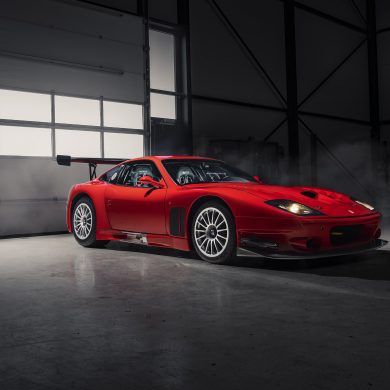
Ferrari 575 GTC Stradale
Type: Race Car
Years: 2003
Production: 1 unit
Engine: 6.0 L Nat Asp V12
Power: 600 bhp
Torque: N/A
0-60 mph: N/A
Top Speed: 208 mph
The Stradale version started as a normal road ready Ferrari 575M Maranello donor car, which was then modified to become the 575 GTC Stradale that is the only one of it’s kind to be road legal. So technically it’s not a real 575 GTC, but a 575M modified to look and performance like one on the road. The 575 GTC was developed by Ferrari Corse Clienti in collaboration with N.Technology in 2003.
Ferrari 550 & 575M Buyer's Guide
Buying Tips & Things to Look for When Buying A Used Ferrari 575 Maranello or Ferrari 575M
The Ferrari 550 Maranello and its successor, the 575M Maranello, are celebrated as modern classics that combine Ferrari’s V12 power with grand touring luxury. These cars deliver a thrilling, analog driving experience, but their age means that certain aspects need close attention. Here’s what to look for when considering a Ferrari 550 or 575M, including common issues, inspection tips, and investment insights.
1. Engine and Timing Belt Health
Both the 550 and 575M are powered by Ferrari’s naturally aspirated V12 engines, known for their impressive performance but requiring regular maintenance.
Timing Belts (550): The 550 Maranello’s timing belt needs to be changed every 3-5 years, as recommended by Ferrari. This is an engine-out service and can be costly, so ensure that any prospective 550 has a documented recent belt change.
Timing Chain (575M): The 575M Maranello uses a timing chain rather than a belt, reducing the need for frequent changes. However, tensioners and chain guides should still be inspected during routine maintenance to prevent premature wear.
Oil Leaks: Look for oil leaks around the valve covers, cam seals, and timing case. Even minor leaks can lead to bigger issues if not addressed, so check the service history for any signs of oil leak repairs.
Fuel System: Fuel pumps and injectors should function without issue, but clogged injectors or fuel pump wear can lead to misfires or poor performance. A clean idle and smooth power delivery indicate a healthy system.
2. Transmission and Clutch Condition
The 550 Maranello was only available with a gated 6-speed manual transmission, while the 575M offered both a manual and an F1-style automated manual transmission. Each has specific points to consider:
Manual Transmission (550 and 575M): Test for smooth, precise shifts and ensure the gated shifter feels solid. Clutch wear is common in both models, so check for documentation of recent clutch replacements or inspect for any slipping during gear changes.
F1 Transmission (575M): If considering a 575M with the F1 transmission, ensure shifts are smooth and consistent, especially during spirited driving. F1 systems can suffer from hydraulic pump and actuator issues, so look for recent servicing of the F1 system and confirm clutch life.
Clutch Replacement: Clutch life varies depending on driving habits. If clutch replacement is needed, be prepared for a costly repair. A recent clutch replacement is a plus, especially in F1 models.
3. Suspension and Handling Components
Both the 550 and 575M feature sophisticated suspension systems designed for a blend of comfort and performance, but age can lead to component wear.
Suspension Bushings: The suspension bushings wear over time and can cause handling imprecision or clunking noises. Look for any recent replacements, and test drive for any suspension noises or loose handling.
Ball Joints: Worn ball joints are a common issue, especially in higher-mileage cars. Check for any rattling sounds when turning or going over bumps, which could indicate worn ball joints.
Shock Absorbers and Adaptive Suspension (575M): The 575M’s adaptive suspension system adjusts damper settings based on driving conditions. Leaking shocks or faulty electronic components can affect performance, so inspect the suspension for leaks and ensure all modes work correctly.
4. Braking System
The braking systems in both models are designed to handle high performance, but wear is common and should be assessed.
Brake Discs and Pads: Both the 550 and 575M are equipped with high-performance brakes that may need regular maintenance. Inspect the brake discs for signs of wear, cracks, or discoloration, and ensure the pads have sufficient life remaining.
ABS System: Both models use ABS, so check that the ABS warning light functions properly. An ABS warning could indicate sensor or module issues, which require diagnosis by a specialist.
5. Cooling System and Radiators
Cooling issues can be a problem with the 550 and 575M, especially if they haven’t been regularly serviced.
Radiator Condition: The radiators are susceptible to damage from road debris, especially on the front-mounted coolers. Inspect for any damage, coolant leaks, or debris buildup around the radiator fins.
Water Pump and Thermostat: The water pump and thermostat should be checked for leaks or improper function, as these can lead to overheating. Regular coolant flushes are essential, so confirm that these have been done at recommended intervals.
Cooling Fans: Check that the cooling fans activate when the engine reaches higher temperatures. Malfunctioning fans can lead to overheating, particularly in warmer climates or during spirited driving.
6. Electrical Systems and Interior Components
Both the 550 and 575M feature advanced electronics for their time, but age can lead to electrical issues.
Sticky Interior Plastics: Like many Ferraris of this era, the 550 and 575M suffer from “sticky” interior plastics, especially around buttons and controls. This issue is cosmetic but may detract from the car’s appearance.
Instrument Cluster and Gauges: Ensure that all gauges, warning lights, and indicators work as intended. Issues with the instrument cluster may require costly repairs, so check that all systems function correctly.
Battery and Electrical Connections: Given that many 550s and 575Ms are driven infrequently, battery health is essential. Check for recent battery replacements or use of a trickle charger, and ensure all electrical systems work smoothly.
7. Bodywork and Frame Condition
Both the 550 and 575M Maranello are built with a mix of steel and aluminum, providing strength and rigidity while reducing weight.
Rust and Corrosion: While the 550 and 575M are less prone to rust than older Ferraris, it’s important to inspect for corrosion on the underbody, door sills, and wheel arches. Proper storage in a climate-controlled environment helps prevent rust.
Paint Condition: Look for consistent paint quality and check for any signs of repainting or body repairs. Minor paint imperfections are common, but mismatched panels or clear coat issues could indicate prior damage.
Convertible Top (575M Superamerica): For the 575M Superamerica, ensure that the “Revocromico” rotating hardtop functions correctly, as repairs to the mechanism can be costly.
Desirability and Future Investment Potential
The Ferrari 550 and 575M Maranello are gaining traction in the collectible car market, appealing to enthusiasts and collectors for their timeless design, naturally aspirated V12 engines, and analog driving experience.
Rising Values: Both the 550 and 575M have seen steady appreciation in recent years. As one of Ferrari’s last analog grand tourers, the 550 holds particular appeal, and values are expected to continue rising. The 575M’s increased performance and F1 transmission option also make it desirable, especially for those seeking a more modern feel.
Manual Transmission Appeal: The gated manual transmission is highly prized by enthusiasts for its engaging experience, particularly as Ferrari has since phased out manual options. Manual-equipped 575Ms are rarer and often command a premium.
Limited Editions: The 550 Barchetta and 575M Superamerica, both limited-production convertible versions, are particularly collectible. The Barchetta’s open-top experience and the Superamerica’s unique rotating roof make them unique among Ferrari’s V12 models, and their rarity drives high demand among collectors.
Future Investment: The 550 and 575M are considered modern classics, particularly valued as Ferrari’s emphasis shifts toward turbocharged and hybrid models. Their naturally aspirated V12 engines and analog characteristics set them apart, making them solid investments for collectors seeking a piece of Ferrari’s legacy.
Conclusion
The Ferrari 550 and 575M Maranello offer an exceptional driving experience, blending V12 power with grand touring comfort in a way that few cars can match. When purchasing one of these models, prioritize examples with a full service history, recent maintenance on critical items like the timing belt (for the 550) or F1 transmission (for the 575M), and minimal modifications. Whether you’re looking for the analog appeal of the 550 or the enhanced performance of the 575M, these grand tourers offer both driving enjoyment and potential for long-term appreciation. With careful attention to maintenance and a focus on well-preserved examples, the Ferrari 550 and 575M Maranello can be rewarding additions to any collection.
The 575M Maranello is a worthy successor to the 550. It's faster, more refined, and even more capable, making it one of the best grand tourers on the market.
Motor Trend (at the time of launch)


